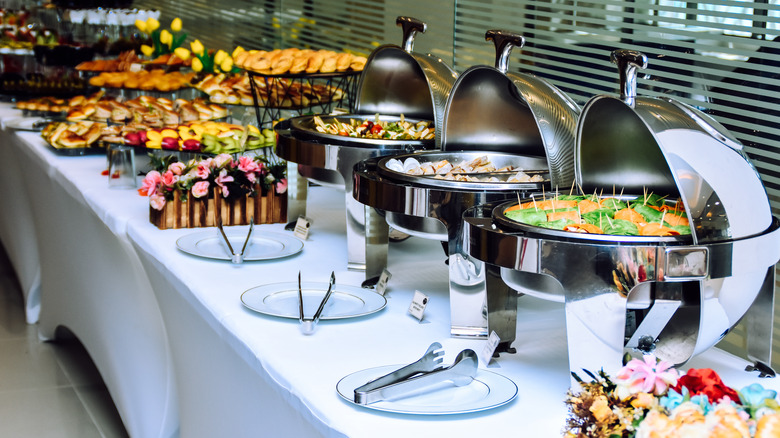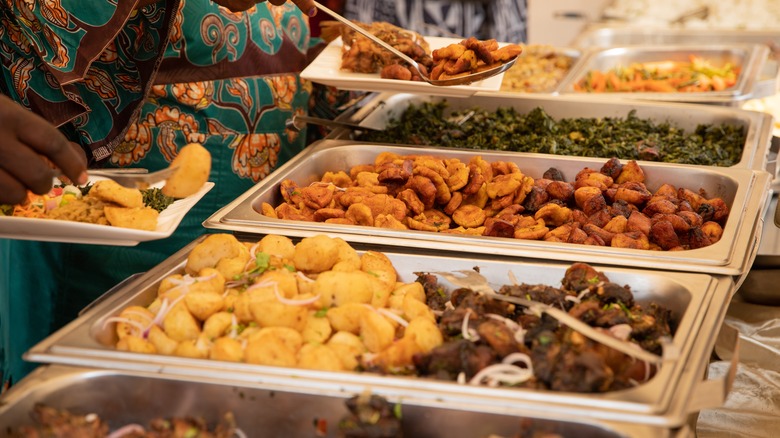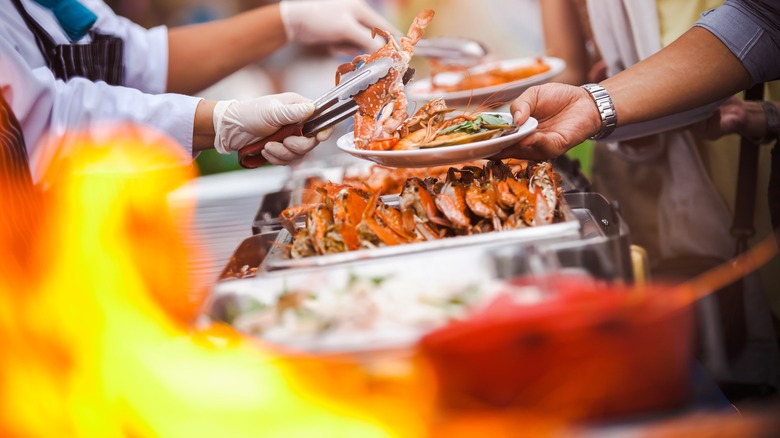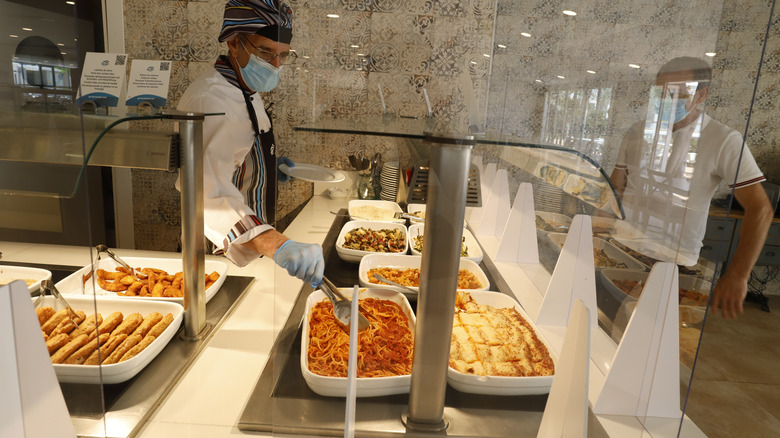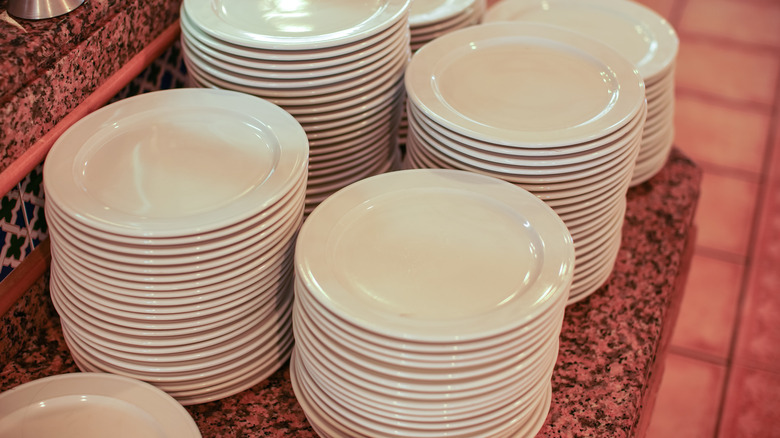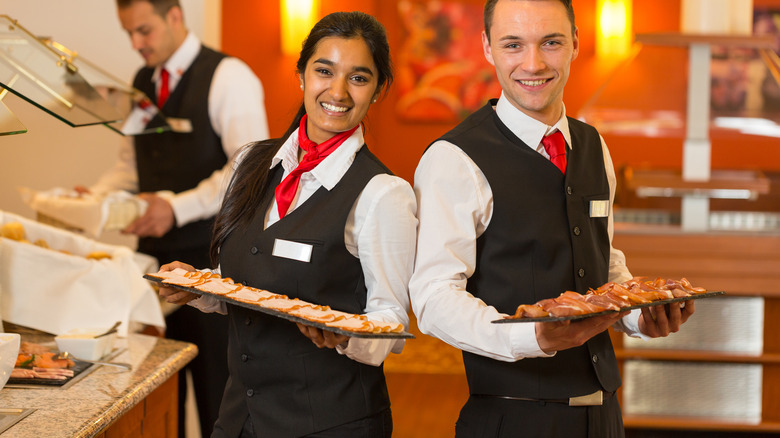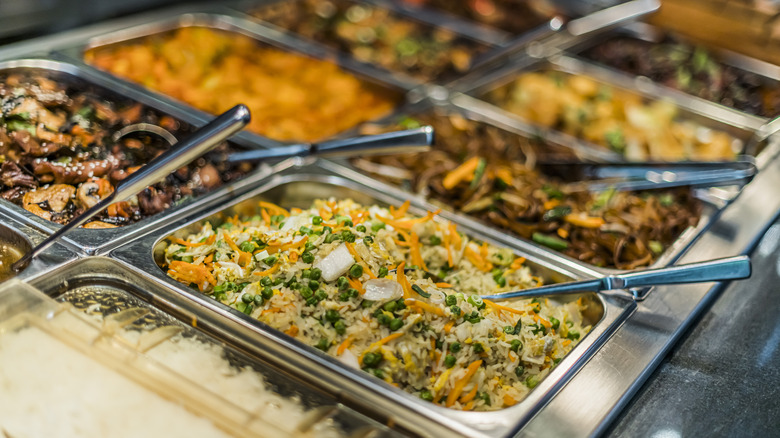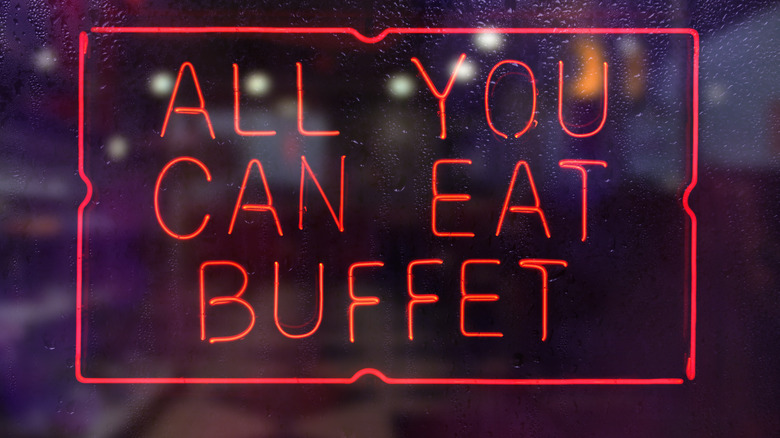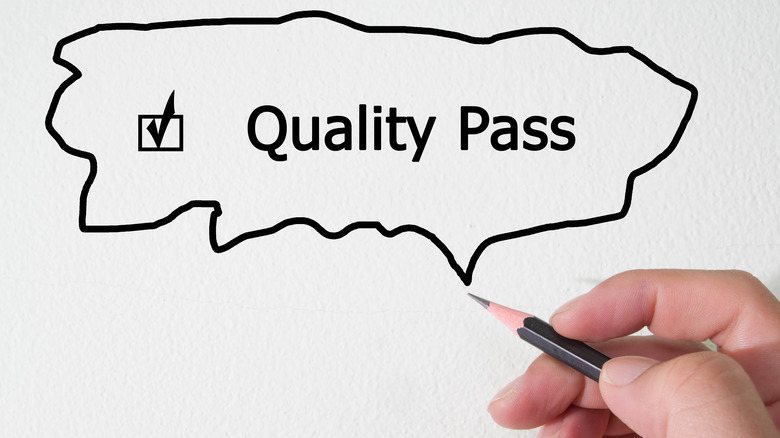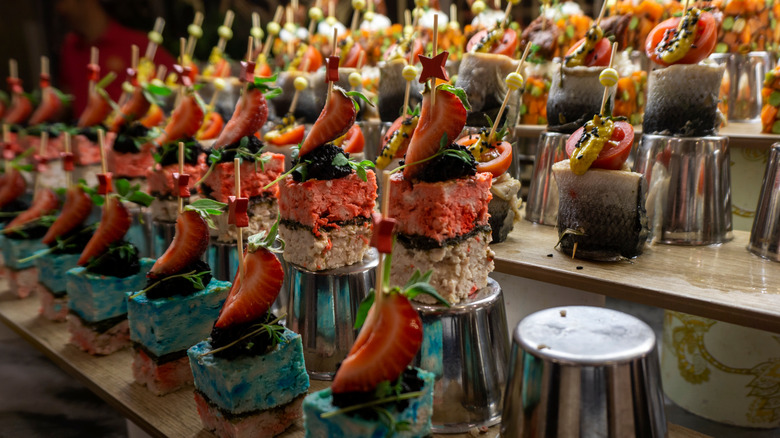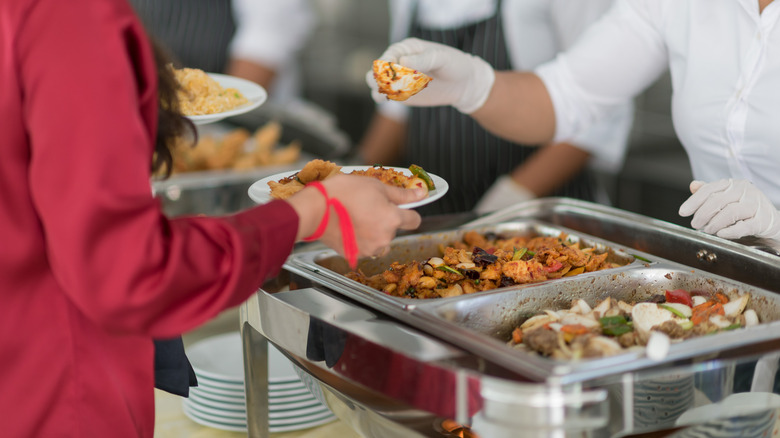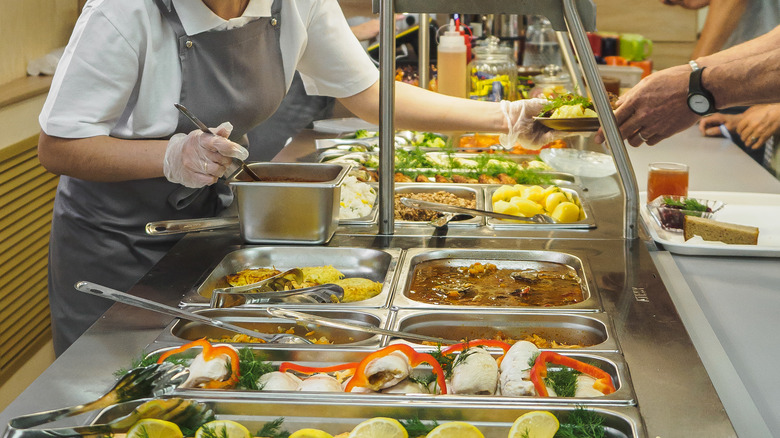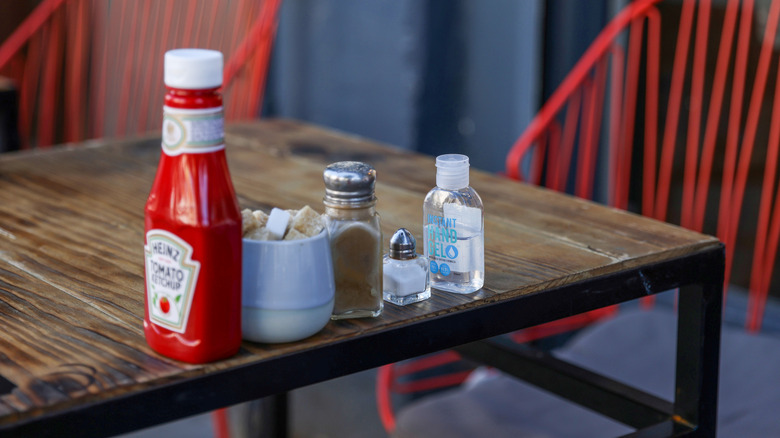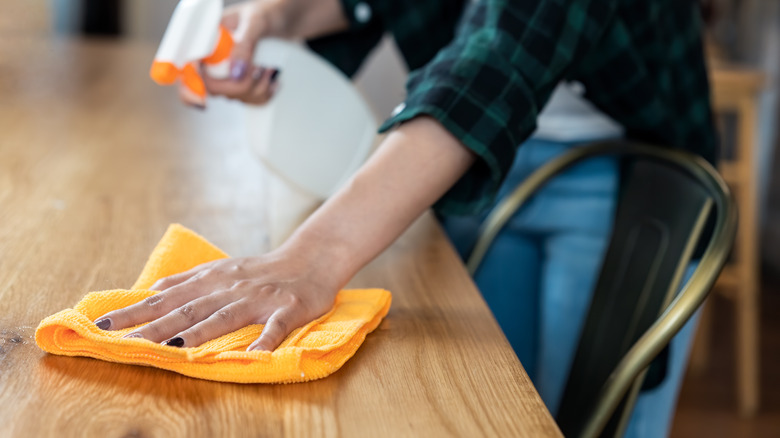13 Red Flags At A Buffet That Should Make You Turn Around
Buffets have been around longer than you might think. They began as a side table that held appetizers and drinks before dinner in Scandinavian homes, way back in the 16th century, per The Runnymede. Eventually, the buffet progressed to what we know now — long tables with trays full of food.
Buffets seem like a great idea — they offer all-you-can-eat food, and it's already prepared. They're helpful if you enjoy a variety of choices in one meal or are in a hurry. Still, have you ever thought about how a large buffet is kept clean? Or how the food safely sits there for hours at a time? What about the rest of the restaurant, such as where you are seated? Keeping a buffet tidy, clean, healthy, and delicious takes a lot of effort.
With so much food set out, you have to wonder how buffets make money. Unfortunately, one way is by buying cheap food in large quantities. Smart buffets even know where to set the cheapest food, which is usually at the front of a buffet line, so customers fill up on the cheaper selections. In this article, we'll look at 14 red flags at a buffet that should make you turn around. No matter how hungry you are, if a buffet doesn't look safe, you should go elsewhere.
Not enough utensils
At a buffet, when there are multiple trays full of food, there should be multiple utensils for serving as well. The only way to keep utensils sanitary is to wash them often and thoroughly. Washing should happen after a utensil is set on an unclean surface. An unclean surface might be the buffet itself or a kitchen counter when a utensil is brought back to the kitchen from the buffet. That's a lot to keep up with at a buffet since servers rely on customers to place utensils back where they belong, and replenishing food in the kitchen often happens if the buffet is busy. With plenty of utensils, dirty ones are quickly removed and placed with clean ones.
Each tray or dish of food at the buffet needs its own designated utensil. The Canadian Institute of Food Safety explains that cross-contamination is a risk when there aren't enough serving utensils. Some people have allergies, and using the same serving spoon for a few different dishes, increases their risk. Also, sometimes foods are raw, such as sushi, and it's dangerous to grab sushi with one utensil and then use that same utensil for something else. It increases the risk of spreading harmful bacteria from raw meat. Even a basket of rolls on a buffet needs a serving utensil, and you want to avoid grabbing bread after multiple hands have already touched it. If a buffet allows serving utensils to be shared, go eat somewhere else.
Hot foods aren't hot and cold foods aren't cold
It seems obvious, right? Cold foods should be cold and hot foods should be hot. However, at a buffet, temperatures are a lot to manage. It's not that customers just want their pasta warm, their soup at the perfect temperature, and their salad chilled. The temperatures must meet safety standards to prevent harmful bacteria from growing and making people sick.
The MN Department of Health writes that at a buffet, cold foods must be kept at least 40 F or less, and hot foods should be at a safe temperature of at least 140 F or higher. As cold foods reach temperatures below the recommendations and hot foods start to cool off, bacteria start to gather for a party and eventually take over. A good buffet will have a regulated setup that keeps food in the safe zone. If the salad is room temperature and wilted or the gravy for the mashed potatoes isn't warm, don't eat at that buffet.
There's no sneeze guard
Thankfully, if the sneeze guard is missing, it's easy to catch as soon as you walk in the door. No sneeze guard is one of the quickest signs that you are at an unhealthy buffet. According to Safely6feet.com, sneeze guards are usually made of acrylic material designed to keep human germs from things like food. The sneeze guard creates a barrier, so if someone accidentally sneezes, coughs, or even just talks a lot at the buffet, the sneeze guard blocks the droplets of saliva, germs, and other stuff from hitting the food.
Tri Living Well explains that one tiny little germ is able to multiply into 8 million germs in one day. Your cute little sneeze can really cause some problems, and just breathing sends airborne droplets of moisture and possible germs into the air and down to the buffet food. Unless everyone holds their breath in line, the sneeze guard is essential.
Not enough clean plates
When at a buffet, the stacks of clean plates should be plentiful. If a restaurant is careless in this area, customers may return with the same plate to add more food, and that's not safe. Table Agent writes that many states have laws about plates and buffets. The law requires that every time a patron goes back to the buffet for more food, they must ditch the used plate and grab a clean one.
Our hands carry plenty of germs, and your saliva is on a plate once you've eaten from it. Bringing it back to the buffet line means serving utensils are grabbing the germs from your hand and saliva from off the plate. It's just gross and shouldn't happen. If the buffet doesn't offer enough plates, you can ask for more or, even better, leave if it doesn't seem important to them.
Also, try to be careful when grabbing a new plate. If you touch several other plates, searching for the perfect one, you are spreading your germs onto other people's plates.
Not enough servers
When we think of buffets, it's easy to forget the need for servers. Buffets are basically self-serve, so why would you need a wait staff? Well, the reality is that its servers who are refilling the food trays, sometimes bringing customers their drinks, clearing away dirty dishes from the tables, and hopefully, just checking in to see how each customer is doing.
When there is a lack of serving at a buffet, you'll end up with too many dirty plates sitting around, food temperatures that aren't being monitored, and food either not being replaced or replaced incorrectly. Most restaurants need to staff enough servers to accommodate around four or five tables per server (via Qwick). At a buffet, servers may have other jobs as well, such as wiping down the buffet area and replenishing food. If a buffet seems short-staffed, you're more likely to eat food that isn't being handled properly.
The pans are gigantic
Bigger isn't always better. Certainly, buffets have a selection of quite a few items, and if they are serving a large crowd, it's understandable that they want to set out a lot of food. However, setting it all out at once in giant trays isn't the safest answer.
TX Natural Pediatrics points out that one way buffets save and make money is by producing food with the industrial cooking model. The huge tray filled with pot roast and gravy isn't going to be the top-notch slow cooker roast and gravy you're used to. Likely, buffet pot roast will be prepared in a way that could easily fill a large container without a lot of thought as to how it would taste. The bigger problem is that if the container is so large, there's no need to replace it with fresher food since it's filled with an endless supply. That means if a dish has been sitting there for hours, you are possibly eating dinner food that was set out for lunch. Temperatures should be monitored, of course, but it is tougher to ensure the food is safe for consumption when it's been out for a long time.
The buffet only runs on weekends
Weekends are a great time to eat out. The workweek is done, and it's time to let someone else do the cooking. The thing is, you need to be leery of a restaurant that is a regular restaurant during the week but turns into an all-you-can-eat buffet on the weekends. That glorious buffet of generosity may at least partially be a table full of the leftovers from the previous week. Here's the good news — restaurants can't serve their customers leftover from the plates of previous customers. That would be ridiculously disgusting and unsafe. However, according to Top Food Info, they can repurpose food made in large quantities and not touched. Sound familiar? That has buffet written all over it. Certainly, no one can say if a restaurant is doing this for sure, but legally, they can. Eating safe leftovers isn't the end of the world, but it does become risky when you're dealing with large batches of food in a restaurant. Ask the restaurant if they make new food, especially for the buffet.
Poor FDA grade
Did you know the places you eat at are graded? The Ascent explains that Americans spend about $2,375 on average per year dining out and grabbing takeout. That's a lot of money going to restaurants. It only makes sense that the FDA pays attention and make sure those eating establishments are up to par.
Smart Sense explains that the FDA uses three grades for a restaurant: A, B, or C. An "A" grade means the restaurant has passed everything, is in good working condition, clean, and hasn't violated any codes. The "B" grade tells customers that the FDA found some fixable issues. A "C" grade is not good. This grade means the restaurant is close to shutting its doors due to violations or other safety issues.
How can you know what the FDA grade is for the buffet you want to eat at? A restaurant's letter grade is often posted somewhere on the storefront, and you can also find it listed in a database by the state the restaurant is in (via Food Safety News). If it's a grade lower than "A" you may want to eat somewhere else.
Food you don't recognize
It's fun to go to a buffet and try foods you've never had before. However, when you're pretty sure what a food item is supposed to be, but it's unrecognizable, stay away. Unfortunately, since buffet-style food is often made in industrial-size amounts, it can dry out quickly and look unappetizing if not well managed. Still, that's no excuse. If food looks crusty, dried out, or just not right, it's best to avoid taking a bite.
Mismanagement of a buffet can lead to safety issues. Perhaps the food has sat out longer than it should, and that's why it's dried out. Some dishes, especially meats, are prepared ahead of time in large quantities and then kept warm with heat lamps. It's great that they're kept warm, but the heat lamps suck the moisture out of the meat, and what's left is a hunk of something that may look more like leather than a steak or ham. Another reason food on a buffet starts to look unappetizing is that the temperature isn't being watched and controlled, leaving the lettuce wilted, shrimp looking limp and warm, and other items just looking unappealing. Remember, it's not just that food like this doesn't look good; it also may not be safe to eat.
Servers aren't wearing gloves
Even before the pandemic, servers at buffets were required to wear gloves. They're handling food, cleaning up messes, and passing out plates and glassware. StateFoodSafety writes that food handlers need to wear gloves when handling food to prevent the spread of bacteria, foodborne illnesses, and germs. However, simply wearing gloves isn't enough. Gloves hold pathogens just as our hands do after they touch something.
At a buffet, just as at any restaurant, workers should be changing gloves after each task. For example, if you see servers clearing plates off a table and then getting behind the buffet to carve meat while wearing the same gloves, it's time to walk out the door. Sometimes gloves are worn to mix ingredients, such as raw meat, and that can be very dangerous if the gloves are reused for a new task. And if you walk in and servers are wearing no gloves at all, it may be best to turn right back around. Bacteria pass easily, and our hands love to spread them.
New food on top of old food
At a buffet, if they just keep adding new food on top of the old food, eventually, someone gets to eat what has been pushed to the bottom of the tray all day or however long the buffet has been running. In an article by Washington State University, they explain that new food should never be placed on top of old food at a buffet, but rather, old food should simply be replaced with fresh stuff. That would always be the case in a perfect world with perfect buffets; however, sometimes a buffet will try to quickly just pour some new food in with the older food to make the trays look full and the buffet tempting. You've probably seen it before. They dump in something like fresh hot mac & cheese over what is already in the mac & cheese tray and then stir it up (sometimes) to mix it all together. If you notice this happening, it could be a sign that the restaurant is careless and trying to cut corners.
Condiments at the table
Some condiments in a restaurant make sense at the table — you want to grab the salt shaker when you need it. However, unless they are wiping them down every time, that salt shaker, as well as the ketchup and mustard, is full of germs from all the hands that touched it before you. Dr. Chuck Gerba of the University of Arizona tells ABC News, "These are objects you're going to touch that can serve as vehicles that are transmitting micro organisms that can potentially make you ill."
Even when sanitized, there are other condiments that are asking for a bacteria party when they aren't refrigerated. According to Today, foods like mayonnaise must be refrigerated and don't use those little convenient mayonnaise packets sitting at the table. Also, dairy products, like cream for your coffee or tea, should come from the refrigerator at a restaurant, including a buffet. The important thing is that if any condiment is at the table while you enjoy your buffet food, there's a good chance it is covered in germs. A good buffet will remove them after each customer, clean them, and bring them back, or better yet, offer disposable packets of ketchup, mustard, and salt and pepper.
The seating area is not clean
You appreciate a fabulously clean, well-run buffet, but all is lost if the seating area is neglected. Sticky tables, chairs full of food particles, and dirty floors are not a pleasant way to eat, and they are also unsafe. Sanitation, cleaning, and disinfecting must take priority to prevent cross-contamination in any restaurant. It's recommended that every day, a restaurant sanitizes the tables and cleans all the seats to prevent fast bacteria growth.
Did you know bacteria can double themselves every 20 minutes? Sure, that's pretty talented, but it's bad news for a dirty restaurant seating area and those eating there. According to Sani Professional, that doubling turns one bacterium into one billion bacteria in 10 hours. It's not a bad idea to go look at the seating area when you enter a buffet. If it isn't clean, you should go find a clean restaurant instead. Cleanliness is a sign that the restaurant cares about preventing illness.
